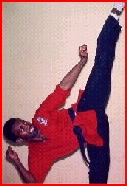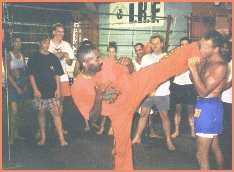
Johnny
"Superfoot"
Davis
KICKS
JOHNNY'S HOME PAGE
johnnyd@akpromotions.org

IKF HOME - NEWS - EVENTS - RANKINGS - SANCTIONING - JOINING - RULES & REGULATIONS - MERCHANDISE - ISCF MMA
THE ART OF KICKING!
Excerpts from Mr.
Davis' Official
IKF Kickboxing Training Manual.
You will quickly discover that although you have good hand skills it is very difficult to move to the top in the sport of Kick Boxing without developing your kicking skills. Interesting enough, I have seen many fighters with great hand skills and limited kicking ability who are successful. In fact I lost my first world championship to such a fighter. However, It was my kicks and punching combinations that allowed me to survive as long as I did. You will see several instances where a Boxer will beat a Kicker and vice-versa. But this I can almost guarantee, the fighter that has taken the proper training measures to balance h/her kicking skills with boxing will be the most effective fighter. Furthermore, It makes the sport more unique from Boxing, as well as more exciting!
There are other reasons why kicks are important.
1. The kicks will keep your opponent in range to score with your feet but out of range for h/her to score with hands.
2. The legs are stronger than the arms therefore, you will have more power in your kicks .
I have always felt that I was a gifted Kicker, but this ability did not come easy. It took many long hours of stretching, and kicking to acquire certain techniques. This is not meant in an arrogant way. However, I feel that some of my kicking exercises and techniques were somewhat unique.
It will be important to practice your kicks for speed by simply thinking fast and asking your body to respond. Power is also essential for having effective kicks. You can greatly increase your power by using the heavy bag. Obviously, timing is of the essence, because if you cannot hit your intended target , you will not be very effective. The focus mitts will increase your focus ability and timing. It is always important to remember to think about punching when your working on your feet and visa-versa. In other words, when your foot comes down you should be in a position to land powerful punches.
Few others have been able the achieve this level of kicking that I am referring to: I have met some of these special people and have picked up many ideas that I have expanded on to enhance my own kicking ability. To name a few: Carl Nelopovitz, Bill "SuperFoot " Wallace, Anthony Thompson and a few others. Here is a simple little technique I use to add more speed and combinations to my kicks and punches.
The Front Kick: This was one of my most effective techniques. Its what I call the "jab" of Kicking . I would constantly throw this technique to my opponents midsection and face. This would keep him at bay, while at the same time allow me to setup other techniques. This kick is so effective because it is closest to your opponent and is thrown in a straight line. (the shortest distance between two points). This kick is also thrown by using one of the smaller areas of the foot, the ball, which makes it more difficult to defend against. I find that a lot of people neglect this kick because of the possibility of injuring their toes. This is why it is important to practice proper form. The best way to accomplish proper form is to drills in fighting form.
Training For The Front Kick: From fighting position - raise knee to target - extend straight into target with a snap - return to starting position Note: can be done with front or rear leg.
 RoundKick: (Right)
If used correctly this kick can give you incredible results. The Round kick is
one of the most commonly used kicks in the sport. I have seen fighter solely use
this kick as their total arsenal and become somewhat successful. Its the kind of
kick that can be thrown from a couple of angles, the 45 degree and 90. The 45
degree kick will allow you to have more speed but will reduce your power. It
will also allow you to setup your hands easier. While on the other hand, the 90
degree kick will give you greater power , but will sightly put you in an arkward
position for punching. You will have to adjust your body, which will slow down
the time between the kick and the punch. The important thing is to know when to
use each kick. For example, If I wanted to land the harder blows with my hands,
I would often throw a quick 45 degree kick to temporarily distract an opponent
and immieadiatly follow up. However, if I had my opponent in a corner I would
use the 90 degree kick as my opponent tried to move out of the corner and in to
my kick. His forward momentum and my proper technique would give me the maximum
power benefit.
RoundKick: (Right)
If used correctly this kick can give you incredible results. The Round kick is
one of the most commonly used kicks in the sport. I have seen fighter solely use
this kick as their total arsenal and become somewhat successful. Its the kind of
kick that can be thrown from a couple of angles, the 45 degree and 90. The 45
degree kick will allow you to have more speed but will reduce your power. It
will also allow you to setup your hands easier. While on the other hand, the 90
degree kick will give you greater power , but will sightly put you in an arkward
position for punching. You will have to adjust your body, which will slow down
the time between the kick and the punch. The important thing is to know when to
use each kick. For example, If I wanted to land the harder blows with my hands,
I would often throw a quick 45 degree kick to temporarily distract an opponent
and immieadiatly follow up. However, if I had my opponent in a corner I would
use the 90 degree kick as my opponent tried to move out of the corner and in to
my kick. His forward momentum and my proper technique would give me the maximum
power benefit.
45 Degree Round Kick: (a) from fighting position -(b) raise knee to chest area at 45 degree angle - (c) extend leg in direction of knee - leg should be completly extended. Note: strike with in-step of foot to solar plexus or head.
90 Degree Round Kick: Repeat above A and B - (c) as leg extends simtaneously turn knee to 90 degree and extend leg in the direction of the knee - recoil to starting postion. Note: It is important to pivot support foot simitanuesly with kick.
The Round kick is also an excellent kick to be used with combinations. For example, begin by throwing lead leg round kick to the solar plexus, recoil- raised knee to head and repeat or by throwing doubles and triples in a rapid fire action at body, head or both. You will sacrifice some power by using these combination. However, with the right training routine, you will be able to retain most of the power in your kicks.
Side Kick: The Side Kick is one of the most neglected kicks in the sport. It is a mystery to me why so many fighters abondoned this most effective kick. This was another one of my favorite kicks I used often. It is a great kick to keep your opponent to the outside, but also the power you get from this kick, if done correctly is phenomenal. The Side Kick is not only great for breaking boards, but it does a great job on your opponents ribs. As we will discuss, proper technique when throwing this kick is vital. I have witness several karatekas that had decent "looking" form in their kick but from the angle that they were throwing the kick it would have been ineffective in a match. Many karateka's are more concern with the way a kick looks when it is complete. However, I recommend that that the kick is monitored and perfected from start to finish. If you and your opponent are standing on fighting position, your feet are aligned, in order for you to get the advantange with your side kick is you should adjust your lead foot so that his toes would be positioned at your heels. Why will this technique work? It will work because of the way you will throw your side kick.The side kick is most effective when is thrown directly to your side. This will mean in order for you to get the maximum benefit from the kick you must throw the kick so that your heel lines up with your back. Lining your opponents toes to your heel will put h/her in direct line of fire. Also by locking your hips into the kick with the proper pivot etc., will give you the power you need to stop any opponent in h/her tracks. Note: The Side Kick does not come from the front of the knee, it comes from underneath and straight out... I mean straight out from your side.
45 Degree Side Kick: From fighting position - raise knee to 45 degree angle - extend leg straight out to side as aforementioned ( heel lined up with back) - lock hips in extended kick - pivot on supporting leg should be done simitanuesly with the extension of kick - recoil to starting 45 degree. Note: The side kick is often done using the blade of the foot. However, I prefer to penetrate the heel. My reasoning is simple. It is because the heel is lined up with the leg bone which will basically not give in as quickly as the blade, which is out of line with the leg bone.
The Hook Kick - This kick is undoubtedly the technique that made Bill " Super foot " Wallace a legend for his excellent kicking ability. It is also a kick that I held very high in my kicking arsenal. The hook kick is a very difficult kick to perfect. It takes lots of long hours and hip conditioning to develop this kick properly. But once you have it , you really have a weapon that will bring you many rewarding foot slaps to your opponents face, as well as a heel to the sides and back of h/er head. It will bring you quick points in tournament fighting or knockouts in the ring of full contact kickboxing. I can remember one of my more successful Hook Kicks. I was competing in a North Carolina Karate Point tournament and I was matched to fight an opponent that was rated on the East Coast and had very good kicks. The match immieadtly turned into a kicking contest. I clearly remember him advancing forward ( with his guard down) and I greeted him with a classic left hook kick that slapped him squarely across the face. The slap was so loud it momentarily stop everyone in the gym. My opponent did not wait for the judges to call a point or even stop the action. He simply took off his gloves and left the arena. Unfortunately, I nor any of my fellow karetekas have seen him on the circuit since. I doubt the kick hurt him physically as much as it did emotionally. However the technique used to cause the " whipping" action that caused the slap, as well as his inability to see the kick is something for discussion. One of the reasons this kick is so effective is because of the angle that it is thrown. It is most effective when thrown from the blind side, that is to say to your opponents back of the head. The whipping of the hip, the rotation of the knee, as well as the pivot of the supporting foot is your main power source.
Training For The Hook Kick: From fighting position - raise knee to 45 degree angle - extend leg straight out at angle of knee - foot should be approximately six to ten inches away from opponents head - important as foot goes past head hip should rotate with knee - at the end of kick, knee should be pointing on the opposite side of head at approx. the same starting distance. The rotating of the hip is vital to the power in the kick as well as for setting up combination kicks. It keeps your opponent in striking range. The back of the heel or the ball of the foot seem to serve as the best areas of the foot to use for striking. It will depend on your intentions. If you only want the "point" and not cause damage to your opponent the ball of the foot is probably more appropriate. Otherwise, you will probably want to use the back of the heel to get the maximum effect.
Spinning Back Kick: The Spinning Back kick is certainly one of the most powerful kicks in the sport of Kick Boxing. This kick requires excellent timing and technique. Its the kind of kick that requires a lot of hard work to perfect. I have had some success with the Spinning Back Kick, most whom have seen me use this kick may say that I have had a lot of success with it. Although, I used this kick often in tournament competition, I was most successful with it in Kick Boxing matches. Kick Boxing allowed me to throw full power in my kicks and punches and therefore, I did not have to hold back in power which I picked up from the momentum in the turn. Yes, I have dropped many people with the Spinnig Back kick. However, the memerable one, I was on the receiving end. I was training with a Middleweight Champion by the name of Francis "Footloose" Farley (Retired IKF Super Middleweight Full Contact Rules World Champion) out of Santa Cruz, California. Admittedly , I had been retired for seven years, so all of my reflexes weren't as sharp, but I held my own. One day as I attempted to throw a long right hand from the outside Farley spun with a devastating and perfect Spinning Back Kick that knocked me back a couple of steps. That was the least of the damage, I had to nurse my bruised ribs for the next month. I was extremely lucky that my ribs were not broken. This is only a short example of the type of power you can get from this kick. It is entirely up to the hard work and dedication you are willing to put in that will make the difference in the effectivness of your Spinning Back Kick.
Training For The Spinning Back Kick: From fighting position - As you begin your spin - simitanuesly raise your rear leg to back kick position - back should only be temporarily turn to your opponent - as soon as back is to opponent the kick should be extended - during your spin keep knee pointing down - striking with the heel of the foot. Note: Allowing the knee to stay down will not telegraph your technique and will allow you to penetrate the heel. Your momentum and timing is essentail to your power.
Basic Order of Footwork-In all to many cases a flat footed fighter is a beaten one. I beleive that for the most part this is true. I understand that there are exceptions to every rule. However, for what I have witnessed, that one who chooses to remain flat footed makes himself vunerable to one who has fleet of feet. What's so ironic about footwork is that many think that they will be required to move and dance like Muhammed Ali. Indeed it only requires the least amount of footwork and body movement to have effective foot work. There was a time when I felt that I had to move like Muhammed Ali. I later realized that I could reserve much more energy and counter better by staying in descent striking range. The type of footwork I am about to discuss will allow you to advance on your opponent as well as enhance your retreating ability. One of the biggest problems many fighter and in particular Kick Boxers have is mantaining their balance after they have throw a kick or a punch. Too often they find themselves stuck in their tracks unable to get out of the way of their opponent. Understanding the proper order of footwork will award you with many offensive and defensive opportunities.
Footwork: From fighting position - step with lead foot approx. 1 foot ( front foot should be flat) - back foot should follow at approx. the same distance. ( back foot lands were front foot was) - repeat steps. Moving backwards the back leg should move first and the front foot should follow at same distance. To the left and right foot movement should be the same. Left leg moves first to left and right leg moves to right first, left leg follows at same distance. Note: Your legs should always remain underneath your body. Do not over extend.
All information on this page
Copyright by Johnny Davis, 1995
Back
To The Training Tips Page CLICK
HERE!
IKF HOME - NEWS - EVENTS - RANKINGS - SANCTIONING - JOINING - RULES & REGULATIONS - MERCHANDISE - ISCF MMA